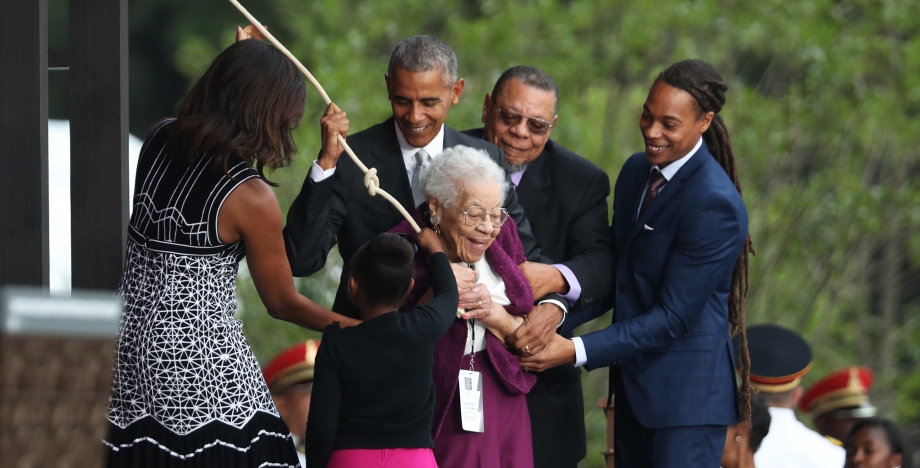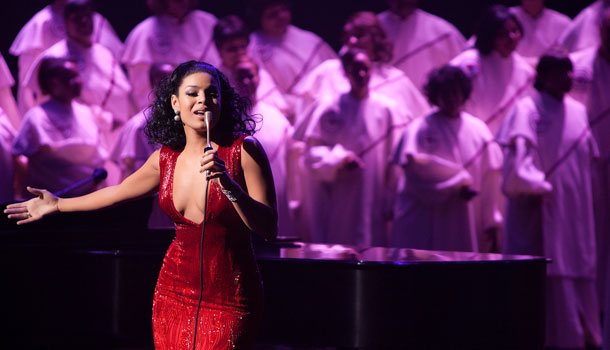
President Obama opened the door to America’s long-awaited first national museum dedicated to Black history and culture Saturday with words that were at times solemn but mainly joyful as he said he hoped the stories contained inside will help everyone “walk away that much more in love” with their country.
In an impassioned speech, Obama pointed out the highs and lows of being African-American, from slavery and Jim Crow segregation to voting rights and economic leaders. That duality lingers still, Obama said, through successes such as his presidency, and trials such as the police killings of Black men.
“We are not a burden on America. Or a stain on America … we are America. And that’s what this museum explains,” Obama said.
He and first lady Michelle Obama joined Ruth Bonner, a 99-year-old direct descendent of a slave, and her family as they rang a bell from the historic First Baptist Church of Williamsburg, Virginia, to signal that the museum was officially open.
The church, believed to be among the first Baptist churches organized entirely by Black people, acquired its Freedom Bell in 1886. It will return to the church for its 240th anniversary later this year.
Linda Johnson Rice, co-chair of the museum’s council and chairwoman of Johnson Publishing Company, said the museum was a more personal way for African-Americans to thank those who came before them.
“They allowed us to see ourselves in ways we never had before. To make us proud of who we are, what we’ve done, and can do.”
Civil rights veteran John Lewis, a Democratic congressman from Georgia who co-sponsored the bill that created the museum, said he hopes visitors will come away with a healthy respect for human dignity, “and a stronger commitment to the idea of justice, truth and democracy.”
“This place is more than a building, it is a dream come true,” Lewis said.
In his speech, Obama imagined himself coming back to the museum someday as a private citizen, “holding a little hand of somebody and telling them the stories enshrined here.”
A shining bronze-colored beacon on the National Mall, only steps away from the White House and the Washington Monument, the new Smithsonian chronicles the complex relationship between the United States and a people it once enslaved and tells the story of those who worked at the changes necessary to bring the country to where it is today.
Thousands gathered on the National Mall to watch the museum officially open its doors and to be among the first inside — if they were lucky enough to get the much-coveted opening day tickets.
“It’s like walking across the desert and finally getting to a fountain of water to quench your thirst. It’s absolutely breathtaking for me,” said Verna Eggleston, 61, of New York City, who was touring the museum later Saturday.
The new museum “symbolizes all of the contributions, the culture and the crisis of Black America,” said Rev. Howard-John Wesley, pastor of Alfred Street Baptist Church in Alexandria, Virginia, whose members donated $1 million to the museum. “It’s a beautiful thing, especially in this day and time when we’re fighting to remind ourselves how important black lives are.”
Inside, museum officials say they have nearly 3,000 items occupying 85,000 square feet of display space, including exhibits like a Tuskegee Airmen training plane and the casket of Emmitt Till, an African-American boy whose murder helped rally the civil rights movement.
“It’s been 100 years in the making. So many people have dreamed about this, fought for this and wanted this to happen,” said U.S. Circuit Judge Robert L. Wilkins, who wrote “Long Road to Hard Truth,” a book about the struggle open the museum. “It’s going to be a testament to their work and a testament to so many of our ancestors that this museum will open on the Mall.”


